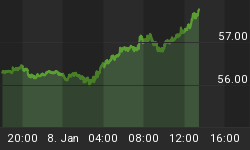Below is an extract from a commentary originally posted at www.speculative-investor.com on 14th December, 2008.
When a market's upward trend is consistent with an existing opinion the market will not be viewed as being in a bubble by the holder of the opinion, regardless of how far the price moves outside the bounds of normal valuation. For example, true believers in the idea that "Peak Oil" was creating a long-term irreversible shortage were not open to the possibility that the oil market was in 'bubble territory' earlier this year. Similarly, enthusiastic supporters of the idea that the world is now experiencing, and will continue to experience, deflation are quick to dismiss the possibility that the bond market could be just another in a long line of bubbles. They are quick to dismiss this possibility because a sharp increase in the bond price (a sharp decline in the bond yield) validates their existing beliefs.
The huge and almost uninterrupted run-up in the T-Bond price began at the start of November and has been accompanied by a $100/oz rise in the gold price and a 30% rise in the AMEX Gold BUGS Index, so unless deflation has suddenly become good for gold and very good for gold stocks it is reasonable to assume that the bond market is NOT discounting deflation. But even if it is discounting deflation it doesn't mean that deflation is actually occurring or is likely to occur in the near future. The reason is that markets can be wrong, especially when they 'go parabolic'. What, for instance, was the NASDAQ discounting when it shot up to 5000 in March of 2000? And what was the oil market discounting when it surged above $140/barrel just 5 months ago?
What, then, makes the deflation forecasters so sure that the bond market is right when other markets that have experienced similar upside blow-offs proved to be less than prescient?
The one thing that makes them sure is that the bond market's price action confirms their existing beliefs. As a result of the recent bond market moon-shot the deflationists are as confident today as the oil bulls were in July of 2008 and the tech bulls were in March of 2000.
One of the interesting aspects of the current situation is that even if the deflationists are right the Treasury market has become so over-priced that it is potentially still an accident waiting to happen. We say this because the yield on the long bond is already near the lows reached in the midst of great deflation of the early 1930s. Moreover, shortly after the yield on long-dated US Government bonds dropped to near today's ultra-low levels in 1931 there was a large multi-month decline in the bond price and rise in the bond yield. And this was despite the fact that bonds were, at that time, denominated in a currency that was convertible into gold at a fixed rate.
The point we are trying to make is that there is substantial downside risk in the T-Bond price right now regardless of what the market is discounting. Given that bonds have been rallying with gold and gold stocks it is likely that the bond market is expecting the Fed to start targeting long-term interest rates via large-scale debt monetisation. In other words, the bond market has probably been rallying in anticipation of additional monetary INFLATION. If the Fed announces such a scheme then the bond price will likely remain near its current elevated level or move even higher (depending on the Fed's target), but if the Fed does not announce some form of artificial support then there's a good chance that the T-Bond price will plunge.
We aren't offering a free trial subscription at this time, but free samples of our work (excerpts from our regular commentaries) can be viewed at: http://www.speculative-investor.com/new/freesamples.html.
















